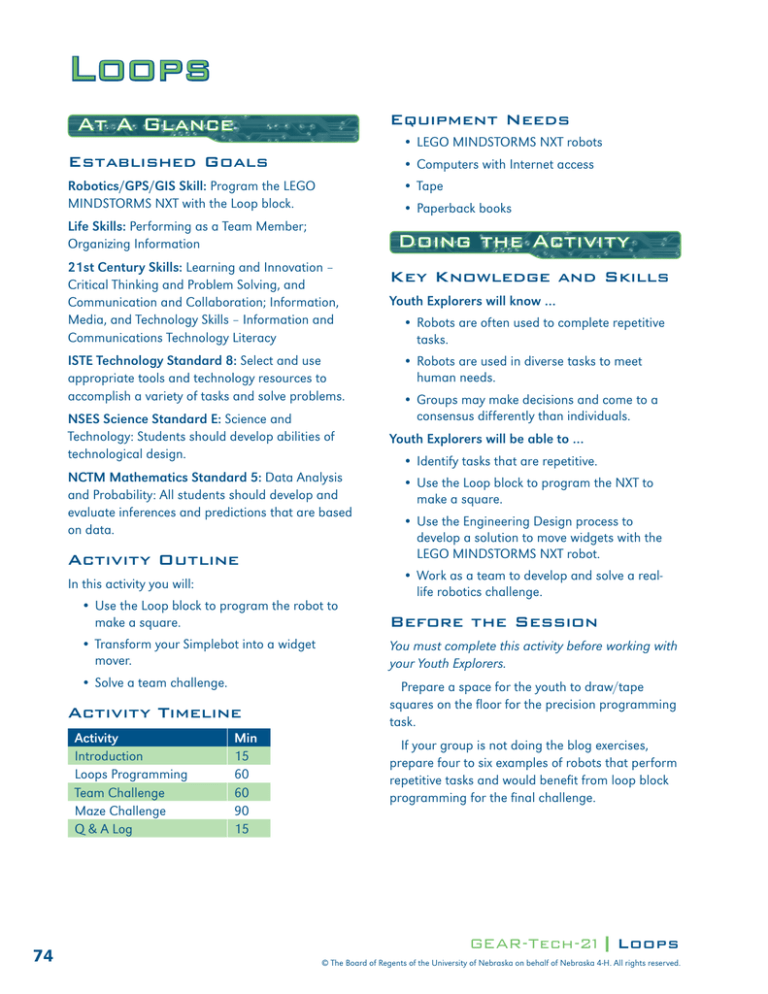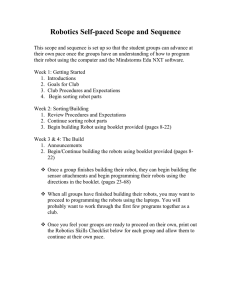
Loops
Equipment Needs
At A Glance
•LEGO MINDSTORMS NXT robots
Established Goals
•Computers with Internet access
Robotics/GPS/GIS Skill: Program the LEGO
MINDSTORMS NXT with the Loop block.
•Tape
•Paperback books
Life Skills: Performing as a Team Member;
Organizing Information
Doing the Activity
21st Century Skills: Learning and Innovation –
Critical Thinking and Problem Solving, and
Communication and Collaboration; Information,
Media, and Technology Skills – Information and
Communications Technology Literacy
ISTE Technology Standard 8: Select and use
appropriate tools and technology resources to
accomplish a variety of tasks and solve problems.
NSES Science Standard E: Science and
Technology: Students should develop abilities of
technological design.
NCTM Mathematics Standard 5: Data Analysis
and Probability: All students should develop and
evaluate inferences and predictions that are based
on data.
Activity Outline
In this activity you will:
Youth Explorers will know …
•Robots are often used to complete repetitive
tasks.
•Robots are used in diverse tasks to meet
human needs.
•Groups may make decisions and come to a
consensus differently than individuals.
Youth Explorers will be able to …
•Identify tasks that are repetitive.
•Use the Loop block to program the NXT to
make a square.
•Use the Engineering Design process to
develop a solution to move widgets with the
LEGO MINDSTORMS NXT robot.
•Work as a team to develop and solve a reallife robotics challenge.
•Use the Loop block to program the robot to
make a square.
Before the Session
•Transform your Simplebot into a widget
mover.
You must complete this activity before working with
your Youth Explorers.
•Solve a team challenge.
Prepare a space for the youth to draw/tape
squares on the floor for the precision programming
task.
Activity Timeline
Activity
Introduction
Loops Programming
Team Challenge
Maze Challenge
Q & A Log
74
Key Knowledge and Skills
Min
15
60
60
90
15
If your group is not doing the blog exercises,
prepare four to six examples of robots that perform
repetitive tasks and would benefit from loop block
programming for the final challenge.
I
GEAR-Tech-21 Loops
© The Board of Regents of the University of Nebraska on behalf of Nebraska 4-H. All rights reserved.
Introduction
Loops
Looping is an important programming concept.
As a programmer breaks a task into its simple
pieces, it is common for these pieces to repeat. In
this activity, the youth will program their robots to
repeat movements. In future activities, loops are
important in telling a sensor to keep looking.
Virtual Self
Repetitive Tasks
Encourage the youth to use YouTube, Flicker,
Firstgov.gov, and other sites to find examples of
robots, then post links and a description of what
the robot does to the club blog.
Loops
The two programming examples shown on the slide
perform the exact same behaviors when run on the
NXT. Using the Loops block can greatly reduce the
amount of program blocks needed for a given task.
In future activities, youth also will use the loop block
configured to repeat indefinitely and/or until a sensor activates the next section of code.
Try It!
Earlier, youth learned that robots are used for tasks
that are dull, dirty, dangerous, and delicate. Many
repeated tasks can be considered dull. Some of
these tasks, like the military example on this slide,
are also delicate and dangerous.
As an extra activity, you can ask the youth to make
a list of tasks they repeat every day and classify
those tasks as dull, dirty, dangerous, and/or delicate.
I
The animation leads the youth through programming the NXT to make a perfect square using the
Loop block and sequences of programming from
previous activities.
GEAR-Tech-21 Loops
© The Board of Regents of the University of Nebraska on behalf of Nebraska 4-H. All rights reserved.
75
If the robot does not return to the “start” square,
often the programming for the turn is not quite
right. It is likely the youth should start their troubleshooting there.
Student Self-Assessment
and Reflection
Worksheet Answer Key
Virtual Self
List three robot applications for repetitive tasks.
Then, post links to them on your blog.
1. Answers will vary but should include a manufacturing example such as an auto assembly
plant.
2.
3.
Loops
•Encourage the Youth Explorers to answer the
questions on their own before discussing with
a small or large group.
•Remind the Youth Explorers that there are no
right or wrong answers to these types of questions. Nonetheless, it is important to allow
each Explorer to self-assess and reflect.
Draft pseudocode for making a square using the
Loop block.
Loop block to repeat the following code four times:
- Go straight for a set distance.
- Make a right-hand turn.
For More Practice
For more practice, or as an end-of-day challenge,
try the Widget Mover Challenge from the Year 1
Robot Challenge Animation found in the Camp 1.0
activity index page.
The Second Maze Challenge should be completed
after the Loops Activity.
76
I
GEAR-Tech-21 Loops
© The Board of Regents of the University of Nebraska on behalf of Nebraska 4-H. All rights reserved.
Team Challenge
Because this is an individual design challenge, the
answers will vary.
Identify
Construct
Problem
Prototype
“The challenge is to modify
the robot to hold books and
to program it to go from
point
A to point B and
return five times.”
Research
Problem
Develop
Solutions
Evaluate
Solution
Share
Solution
•How did your group decide which challenge
project to select?
The Loop block can repeat a section of code.
Answers will vary.
•When you tested the square program, did it
work the first time? What troubleshooting did
you have to do?
Answers will vary.
Generalize to your life! How will it help you in
everyday life?
•What are five tasks you wish a robot could do
for you?
Redesign
•Briefly, explain the Loop block’s capabilities.
•How did you divide tasks in designing the
challenge and solution?
Share what you did! What did you learn?
Process what’s important! What was important
to learn?
Q & A Log
•Select one of the tasks from the previous
question. Design an NXT specifically for that
task. Then, write pseudocode for your NXT to
complete that task.
Answers will vary.
Select
Solution
Apply what you’ve learned! How will it apply to
other situations?
•Besides robots, what other aids do we have in
completing tasks?
•Do any of these aids share characteristics
with robots?
Answers will vary.
I
GEAR-Tech-21 Loops
© The Board of Regents of the University of Nebraska on behalf of Nebraska 4-H. All rights reserved.
77



